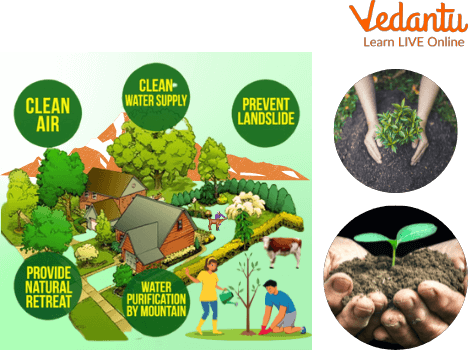




Why Are Trees Essential? Uses, Benefits, and Practical Examples
Trees provide humans with oxygen, store carbon, stabilise the soil, and support a variety of fauna around the globe. They also give us the resources we need for tools and housing. In addition to being necessary for existence, trees serve as a bridge between the past, present, and future because they are the longest-living species on the planet. The preservation and sustainable management of woodlands, rainforests, and trees in urban environments, such as parks, is crucial. In this article, we will study the importance of trees. So, let’s dive in!
Trees
In botany, trees are plants with a trunk, leaves, stem and flowers. Trees are perennial plants with elongated stems and roots. Trees contribute to the environment in many ways. They provide oxygen to the environment and improve air quality. They also help in conserving water and preserving soil. They help in supporting wildlife as well.

Trees
Things We Get from Trees
There are many things which we get from trees. These are the uses of trees in our daily life. Some of them are:
Oxygen - Plants have consistently shown themselves to be both a friend and a helpful hand to mankind.
Fruits and Vegetables - Plant-based foods like fruit and vegetables provide the varied protein, vitamins, fibre, and energy requirements of people and other living things.
Nectar - The nectars found in the flowers that plants generally are used as nourishment by living things like birds and different insects.
Flowers - Plants generate flowers, which humans employ for a variety of religious rituals.
Wood - Humans rely heavily on wood, which can only be obtained through plants, to support themselves, furnish rooms, and operate numerous organisations.
Cotton - Certain plants produce blooms that are very beneficial to humans, such as cotton.
Spices - You can get spices from seeds, fruit, roots, bark, or other plant parts.
Manures - After plants die, they disintegrate to produce an organic material known as manures.
Trees Give Us Oxygen
Photosynthesis is the process that allows trees to consume carbon dioxide to synthesise food. The process involves the tree releasing oxygen from the stomata of the leaves as a byproduct. For photosynthesis, plants also require water and sunlight which are absorbed by roots and leaves, respectively.
It's noteworthy to note that the same quantity of carbon dioxide is required to make the same amount of oxygen. Chloroplasts, the green components of the leaf and the stem, are where the photosynthesis process takes place. Thus, during spring and summer, while their leaflets are green, trees spend the majority of their energy absorbing carbon dioxide and exhaling oxygen.
Importance of Trees
Let’s have a look at the importance of trees. This is the answer to a very important question: how do trees help us? Let’s look at the answer.
Health Benefits of Trees
Tree canopies function as a biological filter, capturing dust and absorbing airborne toxins. Up to 1.7 kg are taken away per tree every year. They also lessen noise and offer cover from the sun.
Trees Encourage Wildlife
Trees support intricate microhabitats. When they are young, they provide food and shelter to incredible communities of fungi, lichen, birds, and insects. When they are old, their trunks also offer the hollow protection that animals like bats, wood-boring insects, tawny owls, and woodpeckers require.
Trees Improve Community Cohesion
Trees enhance a location's unique qualities and boost community pride. Urban woods can be utilised as a teaching tool and to bring people together for outdoor pursuits like bird watching and walking.

Importance of Trees in Our Lives
Summary
Trees and other live plants enhance the beauty of our surroundings, clean the air, serve as sound barriers, produce valuable oxygen, and aid in energy conservation by providing cooling shade in the summer and wind reduction in the winter. We require oxygen to breathe, which trees emit. Trees lessen the quantity of stormwater runoff, which lessens erosion, pollution, and possibly even the consequences of flooding in our waterways.
The habitat of many wildlife species is provided by trees. Many birds and mammals find homes, food, and protection in trees. We concluded our readings from this article here. We hope you enjoyed reading this article.
FAQs on Uses of Trees: Key Benefits & Examples
1. What are the 10 main uses of trees for us?
Trees are very helpful to us in many ways. Here are ten important uses:
- They give us oxygen to breathe.
- They provide delicious fruits like apples and mangoes.
- We get wood to make furniture, doors, and pencils.
- They give us shade from the hot sun.
- Their roots hold the soil and prevent soil erosion.
- Many trees give us medicines to cure sickness.
- They are homes (habitats) for many birds and animals.
- They help in bringing rain by regulating the water cycle.
- We get materials like rubber and gum from trees.
- They make our world look beautiful and green.
2. How do trees help in keeping our environment clean?
Trees act as natural cleaners for our environment. They help by absorbing harmful gases like carbon dioxide from the air, which is a major cause of air pollution. Through a process called photosynthesis, they release fresh oxygen that all living beings need to breathe. Their leaves can also trap dust and pollutants, making the air we breathe much cleaner and healthier.
3. What are some everyday things we get from trees?
Many things we use daily come from trees. Your notebook and storybooks are made of paper, which comes from wood pulp. The pencil you write with is made of wood. The chair you sit on and the bed you sleep in are often made from wood. Even some of the food you eat, like nuts and spices, and the rubber in your eraser, come from different parts of trees.
4. Why are trees often called the 'lungs of the Earth'?
Trees are called the 'lungs of the Earth' because they perform a function similar to our lungs, but for the entire planet. Just like our lungs take in oxygen and release carbon dioxide, trees do the opposite. They 'breathe in' the harmful carbon dioxide from the atmosphere and 'breathe out' fresh oxygen, which is essential for us and all animals to survive. This makes them vital for keeping the Earth's air breathable.
5. How do the roots of a tree help the soil?
The roots of a tree are like a strong net spread out under the ground. They grip the soil particles tightly, holding them in place. This is very important because it prevents the rich top layer of soil from being washed away by heavy rain or blown away by strong wind. This process is called preventing soil erosion, and it helps keep the land fertile and stable.
6. What would happen to animals and birds if all the trees were cut down?
If all the trees disappeared, it would be a disaster for animals and birds. Trees provide shelter and a safe place to live for countless creatures. Birds build their nests on branches, and animals like monkeys and squirrels live in trees. Trees are also a primary food source, providing fruits, nuts, and leaves. Without trees, these animals would lose their homes and food, and many would not be able to survive.
7. Besides common uses like wood and paper, what are some special products we get from trees?
Beyond the obvious uses, trees provide many special products. For example, the bark of the Cinchona tree gives us quinine, a medicine used to treat malaria. The sticky sap of the rubber tree is used to make rubber for tires and shoes. We also get gum from the acacia tree, and aromatic oils from trees like sandalwood and eucalyptus, which are used in soaps and perfumes.
8. Why is planting new trees important for our future?
Planting new trees, or afforestation, is crucial for the health of our planet and our future. As our population grows, so does pollution. Trees help fight this pollution by absorbing carbon dioxide. They also help combat climate change, ensure there is enough oxygen, conserve water, and provide resources for future generations. Every tree we plant helps make the Earth a better and healthier place to live.









